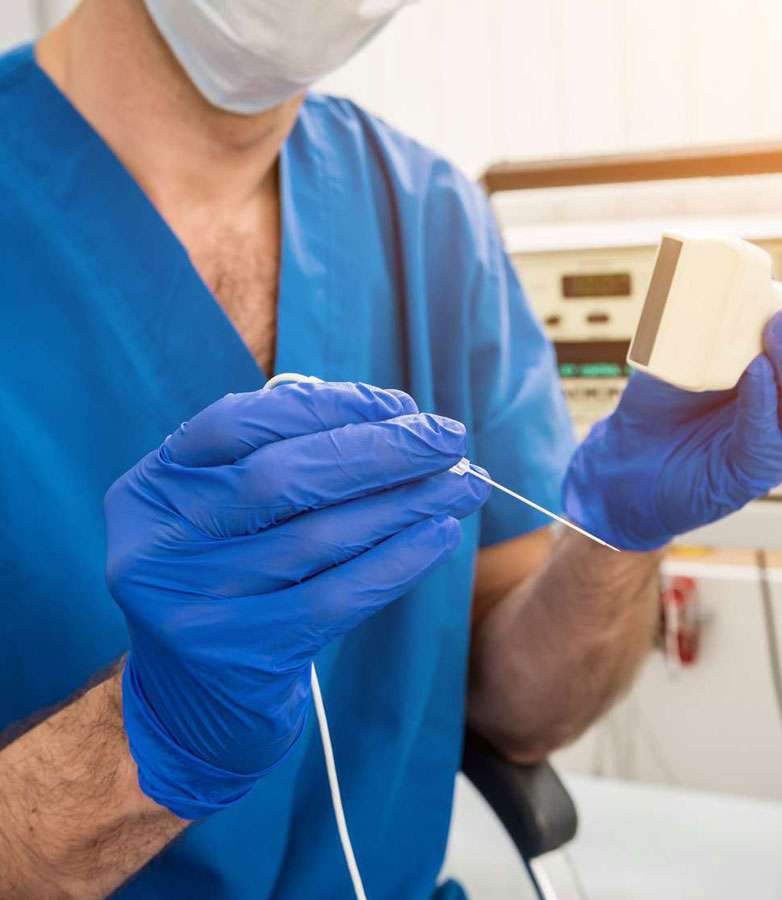
PRF – Pulsed Radio Frequency Ablation
What is pulsed radiofrequency (PRF)?
Pulsed Radiofrequency therapy is a pain management intervention to provide long-term pain relief when the pain relief from nerve blocks have lasted only for a short period. PRF is the next step in the treatment protocol after a diagnostic nerve injection. It is unique in that PRF does not destroy the nerve completely but resets the pain nerve (i.e. Neuromodulation), to reduce pain and provides longer-term relief.
PRF is offered to patients with chronic pain originating from nerves.
Radiofrequency ablation (RFA) is a minimally invasive procedure that uses heat generated by radiofrequency waves to destroy abnormal tissue growths. RFA is often used to treat chronic pain in patients who have not found relief from other treatments.
In Sydney, RFA is a popular treatment option for individuals suffering from chronic pain. The procedure is performed by an interventional pain specialist or a radiologist, and can be completed on an outpatient basis. The treatment involves inserting a small needle through the skin and into the targeted tissue. The needle is connected to a radiofrequency generator that delivers a high-frequency electrical current to the tissue, creating heat that destroys the targeted cells.
RFA has been used to treat a wide range of conditions, including back pain, neck pain, arthritis, and cancer pain. The procedure has been shown to provide long-lasting pain relief and can significantly improve a patient’s quality of life.
The benefits of RFA include its minimally invasive nature, which reduces the risk of complications and promotes faster healing. Unlike traditional surgery, RFA does not require general anesthesia or a hospital stay, and patients can often resume their normal activities within a few days of the procedure.
One of the leading centers for RFA in Sydney is the Pain Management Clinic at PainMed. The PainMed offers a comprehensive range of pain management services, including RFA, and is staffed by a team of highly trained pain specialists and radiologists.
Patients seeking RFA treatment at the Pain Management Clinic undergo a thorough evaluation to determine if the procedure is appropriate for their condition. If RFA is recommended, patients are given detailed instructions on how to prepare for the procedure and what to expect during and after the treatment.
During the procedure, patients are positioned on a table and given local anesthesia to numb the area where the needle will be inserted. The physician then uses fluoroscopy, a type of real-time X-ray, to guide the needle to the targeted tissue. Once the needle is in place, the radiofrequency generator is turned on, and heat is delivered to the tissue for a few minutes.
After the procedure, patients are monitored for a short period of time before being discharged. Most patients experience some discomfort or soreness at the site of the procedure, but this typically resolves within a few days. Patients are advised to rest for the first 24 hours after the procedure and to avoid strenuous activities for a few days.
What’s involved in the provision of PRF?
The radio frequency machine produces an intermittent (pulsed) electrical current through a needle which stimulates the nerve. The process should not be painful. It is a treatment that uses radio waves to control pain. A rapidly changing electric current is applied using a needle to a specific nerve which is causing problems. This causes changes to the nerve which can provide pain relief by preventing pain signals from reaching the spinal cord. Other signals from this nerve are not blocked.
During the procedure you will also be given a local anaesthetic and steroid injection to help relieve short term pain following the PRF.
What are the benefits?
PRF treatment can give long lasting pain relief for between three to18 months but everyone experiences the effects in a different way.
What are the risks?
Overall PRF injections are very safe and serious side effects or complications are rare. However, like all injection procedures there are some risks: Common risks include bruise or tenderness at the site of injection, an increase in your pain – this should only last a few days. Serious risks like infection, bleeding or nerve damage is rare.
What happens after an PRF?
You will be monitored for up to monitored closely in the recovery room for 30 minutes after the injection. When you are ready to leave, the staff will give you discharge instructions. You will need to keep a pain diary. It is important to maintain a diary to help the doctor ascertain the success of the RFA.
You may feel sore for one to four days. It may be due to muscle and nerve irritation. Your back may feel numb or itchy for a couple weeks. Maximum pain relief normally comes in two to three weeks but can take as long as six to eight weeks.
How long can I expect pain relief?
Your pain may or may not return after PRF lesioning which can range from 9 to 18 months. If it does, another RFA can be done.
How do I prepare for the procedure?
Please advise staff if you are:
- Taking blood thinners (especially warfarin and clopidogrel)
- Diabetic
- Pregnant (or any chance of you being pregnant).
- Allergic to iodine, betadine, shellfish, local anaesthetics, or steroids.
- Unwell (especially if you have an infection)
Operating department staff may advise you to:
- Fast
- Take your usual medications (apart from those mentioned above)
- Arrange for someone to accompany you home
PRF – Pulsed Radio Frequency Ablation
What is pulsed radiofrequency (PRF)?
Pulsed Radiofrequency therapy is a pain management intervention to provide long-term pain relief when the pain relief from nerve blocks have lasted only for a short period. PRF is the next step in the treatment protocol after a diagnostic nerve injection. It is unique in that PRF does not destroy the nerve completely but resets the pain nerve (i.e. Neuromodulation), to reduce pain and provides longer-term relief.
PRF is offered to patients with chronic pain originating from nerves.
What’s involved in the provision of PRF?
The radio frequency machine produces an intermittent (pulsed) electrical current through a needle which stimulates the nerve. The process should not be painful. It is a treatment that uses radio waves to control pain. A rapidly changing electric current is applied using a needle to a specific nerve which is causing problems. This causes changes to the nerve which can provide pain relief by preventing pain signals from reaching the spinal cord. Other signals from this nerve are not blocked.
During the procedure you will also be given a local anaesthetic and steroid injection to help relieve short term pain following the PRF.
What are the benefits?
PRF treatment can give long lasting pain relief for between three to18 months but everyone experiences the effects in a different way.
What are the risks?
Overall PRF injections are very safe and serious side effects or complications are rare. However, like all injection procedures there are some risks: Common risks include bruise or tenderness at the site of injection, an increase in your pain – this should only last a few days. Serious risks like infection, bleeding or nerve damage is rare.
What happens after an PRF?
You will be monitored for up to monitored closely in the recovery room for 30 minutes after the injection. When you are ready to leave, the staff will give you discharge instructions. You will need to keep a pain diary. It is important to maintain a diary to help the doctor ascertain the success of the RFA.
You may feel sore for one to four days. It may be due to muscle and nerve irritation. Your back may feel numb or itchy for a couple weeks. Maximum pain relief normally comes in two to three weeks but can take as long as six to eight weeks.
How long can I expect pain relief?
Your pain may or may not return after PRF lesioning which can range from 9 to 18 months. If it does, another RFA can be done.
How do I prepare for the procedure?
Please advise staff if you are:
- Taking blood thinners (especially warfarin and clopidogrel)
- Diabetic
- Pregnant (or any chance of you being pregnant).
- Allergic to iodine, betadine, shellfish, local anaesthetics, or steroids.
- Unwell (especially if you have an infection)
Operating department staff may advise you to:
- Fast
- Take your usual medications (apart from those mentioned above)
- Arrange for someone to accompany you home


